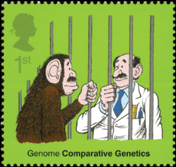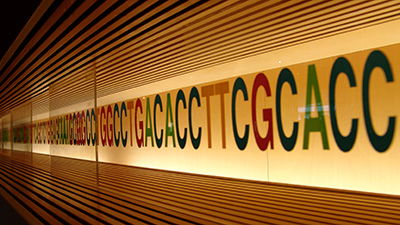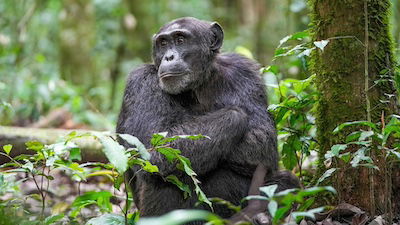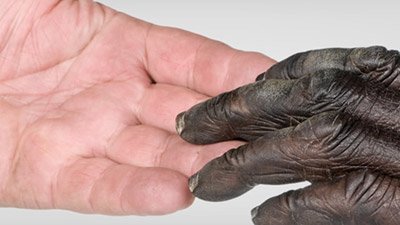
Apes Are Our Brothers—Just Ask the Post Office
'Do you realise our DNA is 98.5% identical?’ These are the words in an advertisement for the first-class stamp in a new series called ‘The secret of life,’ released by Royal Mail (UK).





“Do you realise our DNA is 98.5% identical?” These are the words in an advertisement for the first-class stamp (top right) in a new series called “The secret of life,” released by Royal Mail (UK). The stamps commemorate the 50th anniversary of Watson and Crick’s discovery of DNA’s structure and recent advances in human genome research.
Posters advertising the stamps are plastered all over Post Offices in the UK—even AiG staff from the US were bombarded with this message during a recent speaking trip there [see Busy in Britain].
Cartoonist Peter Brookes of the London Times drew the pictures, using humor to make his message clear. For his first-class stamp, he chose to show the link between apes and scientists, and label it “comparative genetics.” Obviously, this implies that one of the most significant outcomes of DNA research is its evidence for human evolution.
Another stamp in the collection promotes a similar message. According to Royal Mail’s promotion on its Web site, the stamp titled “The End of the Beginning,” which shows scientists completing a jigsaw puzzle, “signifies that the discoveries made so far, and the mapping that continues, present us with the method of finding the beginning of life (emphasis added).”1
Discrediting “the god hypothesis”
Indeed, the title of the whole series, “The secret of life,” is taken from a famous quote by one of the discoverers of DNA’s double-helix structure, Francis Crick, who saw it as a confirmation of evolution and a death knell to religion. (Crick announced fifty years ago at a pub in Cambridge: “We have discovered the secret of life.’)
An outspoken atheist, Crick was motivated by a bigger prize than the Nobel laureate. He openly admits that he has devoted his life to discrediting what he considers to be the two most powerful “design” arguments for God: chemicals can’t explain life and chemical processes can’t explain human consciousness. As he explained to the London Telegraph:
“I went into science because of these religious reasons, there's no doubt about that. I asked myself what were the two things that appear inexplicable and are used to support religious beliefs: the difference between living and nonliving things, and the phenomenon of consciousness.”2
Although Crick’s work with DNA is more widely known than his work on the human brain,3 both lines of research were intended to confirm the same conclusion: “The god hypothesis is rather discredited.”
Of course, nobody can deny the significance of Crick’s discovery. In 1953, it was still a deep mystery how heredity worked—how living things reproduced and transmitted their characteristics. The discovery of DNA’s structure truly revolutionized biology, and led to the mammoth Human Genome Project (see Genome Mania—Deciphering the human genome: what does it mean … ). The potential medical benefits from this project are truly exciting, as the stamp “Medical futures” emphasizes.
On the other hand, the belief that DNA research improves our understanding of human origins is a farce. Although the field of comparative genetics has revealed some interesting facts about the similarities (and differences) of DNA among different species, it says nothing about the origin of our DNA or the historical relationship between species.
Just because we share half our DNA with bananas, doesn’t mean we’re “half a banana.”4 Similarly, if there were 98% genetic similarity between humans and chimps wouldn’t mean that we were 98% chimps.5 But in fact, recent evidence indicates that the genetic similarity is significantly less than this.
The real lesson of DNA
The real, unheralded lesson of the past 50 years of DNA research is the evidence of an amazing Designer, who made all things, including a marvelously complex, efficient “information system” for encoding life—something that could not have arisen by mere time and chance.
DNA obeys the laws of physics and chemistry, but it carries something much more than that, something which is not known to arise from mere physics and chemistry—information.6 A car functions according to the physical laws—i.e. there is nothing “spooky” that makes cars operate. But the physical laws plus time plus chance could never build a car. The missing ingredient is information—the intelligent purposive design impressed onto those raw materials.
In the same way, DNA carries the blueprint for living things, which is transmitted from one generation to the next, like a series of robots programmed to pass on their programs to other robots. But since observational science has never revealed any natural process that can create information, i.e. “write the program,” the most logical conclusion is that the programs themselves, i.e. the information in the original created kinds, arose from an intelligent mind—the same way programs arise today.
But don’t expect such an obvious scientific conclusion from a world steeped in evolutionary rebellion against its Maker.
Footnotes
- 2003 collection:
the secret of life
<www.royalmail.com/portal/default/all/home?shopConsigniaPage=/shop/catalog/shopDetail&id=prod240003&_requestid=8851>, 25 February 2003. - Do our
genes reveal the hand of God?
<http://www.telegraph.co.uk/connected/main.jhtml?xml=/connected/2003/03/19/ecfgod19.xml>, 20 March 2003. - The second half of Crick’s life focused on brain research, as he explained in his 1994 book The Astonishing Hypothesis: The Scientific Search for the Soul, which claimed, “Your joys and your sorrows, your memories and your ambitions, your sense of personal identity and free will, are in fact no more that the behavior of a vast assembly of nerve cells and their associated molecules.”
- Wieland, C., Furry little humans? Creation 24(3):10–12, 2002.
- Note that the 98% figure, which gets bandied about in the press, refers to chimpanzees, not apes, and it has been lowered to about 95%. See Greater Than 98% Chimp/Human DNA Similarity? Not Any More.
- I.e. the sequence of symbols with which DNA is constructed. This sequence is not inherent in the raw chemistry of DNA, but arises from the information in the parent’s DNA.

Answers in Genesis is an apologetics ministry, dedicated to helping Christians defend their faith and proclaim the good news of Jesus Christ.
- Customer Service 800.778.3390
- Available Monday–Friday | 9 AM–5 PM ET
- © 2026 Answers in Genesis



